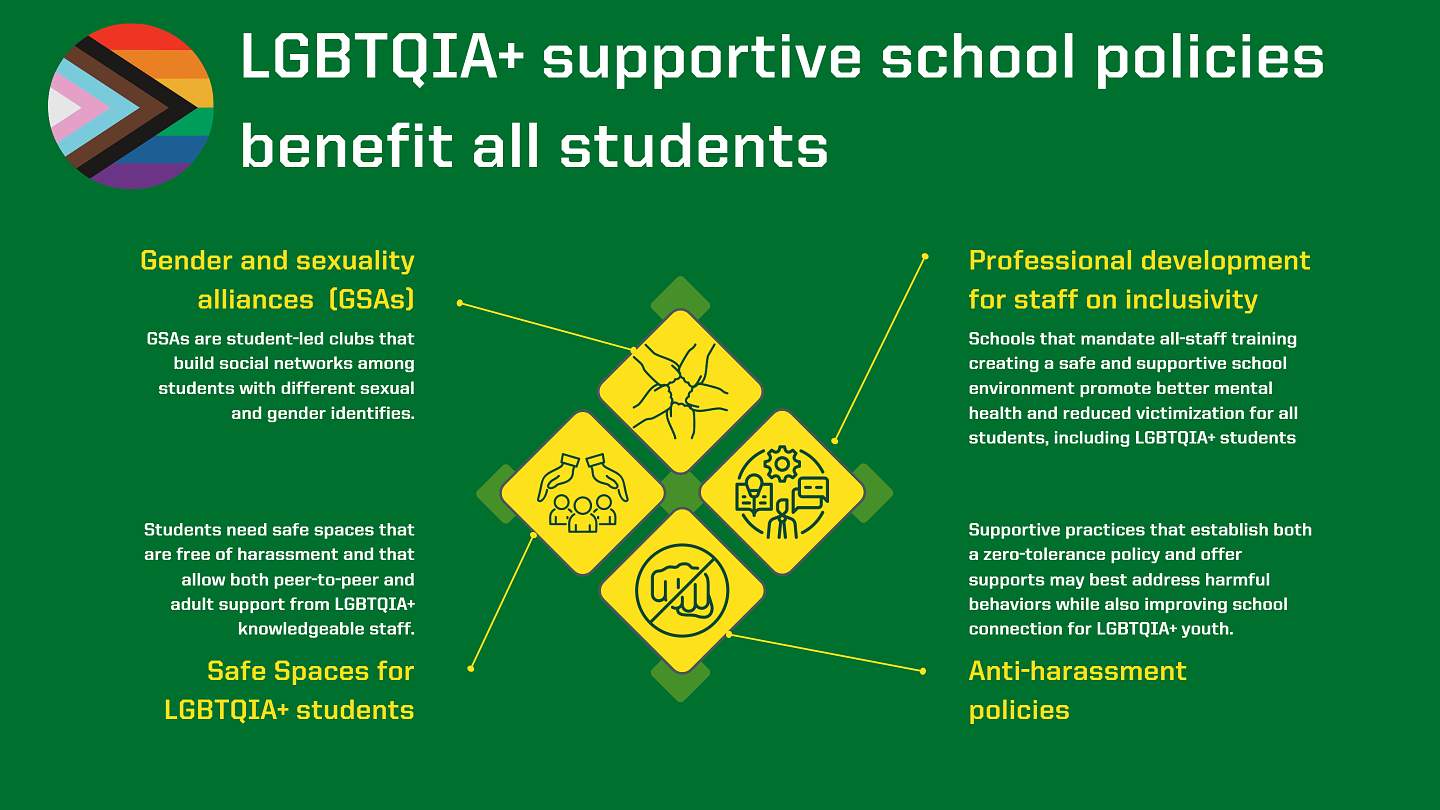By Maria Schweer-Collins, PhD, Research Assistant Professor, HEDCO Institute for Evidence-Based Educational Practice
To celebrate Pride Month and to launch our blog series on school belonging, this month’s post focuses on school belonging and connectedness for youth who identify as lesbian, gay, bisexual, transgender, questioning, intersex, asexual, or identify their sexual orientation or gender identity in other ways (LGBTQIA+). Sexual and gender minority youth tend to be at higher risk for peer victimization and all forms of harassment, including experiences of stigma and discrimination. Yet there is one central factor that can help mitigate the harm LGBTQIA+ youth are more likely to experience in their school settings and it takes the entire school community to shift those harms. Yup, you have it right, it’s school belonging.
What is school belonging?
Let’s start with a simple definition of school belonging – experiencing supportive and caring relationships in the school social environment. Belongingness is a central concept in the field of psychology, helping to explain how connection in genuine relationships is a powerful motivator of behavior. It makes sense that belongingness worked its way into educational theory, where it helps to describe how and why students show different academic and psychosocial outcomes based on their connection to and experiences with teachers, staff, and peers. School belonging is complex and extends beyond 1:1 relationships and social connectedness. It also broadly speaks to a student’s school engagement and perceptions of safety in the school and school-based supports.
The data on the importance of school belonging are compelling
Why does school belonging matter? Well, the data are compelling: school belonging, at all K-12 educational levels, has been documented time and again as a predictor of student academic success and psychosocial well-being. A recent review of the literature suggests that school belonging and connectedness could be preventative for many common mental health challenges in students, such as depression and anxiety. Importantly, the positive effects of belonging in and outside of school are lasting – they provide benefits for students beyond their time in a given school community.

School belonging strategies specific for LGBTQIA+ youth
But what is a positive and supportive school environment for LGBTQIA+ youth? Before diving into these specific strategies, it is important to recognize that systems-level action is necessary. A recent policy brief published by MDRC did just that by interviewing district leaders and summarizing district-level strategies to improve student belonging. Some of the most effective strategies included involving youth voices in addressing student needs and in identifying solutions; increasing multitiered support systems, which include universal supports delivered to all students; and using restorative or supportive (versus punitive) discipline practices. Finally, professional development training delivered at the district level to all teachers and staff, with a focus on inclusivity is another central component.
The U.S. Department of Education recently released a toolkit on the topic “Creating Inclusive and Nondiscriminatory School Environments for LGBTQI+ Students.” The toolkit describes how schools can make steps toward improving the safety and belonging of LGBTQ+ students through four key strategies:
- Gender and sexuality alliances
- Safe spaces for LGBTQ+ students
- Professional development training for staff on inclusivity
- Anti-harassment policies
Gender and sexuality alliances. Gender and sexuality alliances, often referred to as GSAs, are student-led clubs that support students in building social networks with different sexual and gender identities. Meta-analytic research suggests that schools with GSAs tend to be reported by students as feeling safer and being more inclusive of gender and sexual diversity. GSAs often have to be approved at the district level.
Safe Spaces for LGBTQIA+ students. It’s vital that students have safe spaces that are free of harassment and that allow both peer-to-peer and adult support from LGBTQIA+ knowledgeable staff. Dozens of examples of safe space programming for LGBTQ+ students exist. For example, here in Oregon, a notable example is TransPonder, an organization that provides local support, including behavioral health, resources, and education for the trans/gender diverse community and its allies.
Professional development training for staff on inclusivity. Schools that mandate teachers and staff receive training on creating safe and supportive school environments for all students, regardless of sexual orientation or gender identity, promote better mental health and reduced victimization for all students, including LGBTQ+ students. Thus, ensuring that training on inclusivity extends to gender and sexual minority students can have a profound effect on the experience of the LGBTQIA+ student, from reducing the occurrence of homophobia or heteronormativity to increasing the self-efficacy of teachers and staff in supporting the specific needs of LGBTQIA+ students.
Anti-harassment policies. The bullying and harassment of sexual and gender minority youth in schools is pervasive and research documents that the way harassment is addressed matters. Specifically, supportive practices that establish both a zero-tolerance policy and offer supports may best address these harmful behaviors while also improving school connection for LGBTQIA+ youth. What are supportive practices? Although there isn’t one definition, supportive practices commonly exist at the school level, through added support services like school-wide positive behavioral interventions and supports.
HEDCO Institute Blog 2 - June 30, 2023
Explore more:



